- Author: Gregory C Ira
I recently came across a national forum thread on iNaturalist where someone was curious to know more about the value of becoming a “certified” naturalist. Not surprisingly, there was a wide range of opinions. These ranged from supportive to skeptical to cynical. Because many of the responses came from people who have not taken a course themselves, I thought it might be valuable to share some data from people who actually completed a course – in this case, the UC California Naturalist course offered by over 60 different organizations around the state.
To summarize the forum discussion, the believers - commonly people who actually have taken a course – found that taking a course was useful for people who were new to an area, had no previous science background, or were looking for ways to connect and engage in volunteer service locally. The skeptics often cited the improbability of becoming a “master” or expert in anything after just taking a short course or the fact that a degree in many science fields would render certification unnecessary. Finally, the more cynical views suggested that certification was just another ploy to separate people from their money.
In California, our End-of-Course Evaluation provides useful insight into why people pursue naturalist certification, as well as their level of satisfaction with the course. The five most commonly cited reasons for pursuing naturalist certification from over 1,000 respondents were: 1) to learn more about the local environment, 2) learn about conservation issues, 3) spend time outside, 4) career development, and 5) meet people with similar interests. Securing the certification ranks sixth out of ten choices and is rarely the driving factor for taking the course.
Regardless of their rationale for taking the course, 72% of those who completed the course were very satisfied with their experience, and 93% were either very or somewhat satisfied. Regarding putting their experience to use, 95% of the respondents indicated that participation in the course improved their capacity to do their volunteer service, and the majority indicated they plan to do more in the coming year. Increasingly, more course participants are looking at the course as a form of professional development, and about 93% indicated that participation in the course improved their capacity to do their work or the work they would like to do in the future. Anecdotally, we find the social learning component of our program and our efforts to create an inclusive community of naturalists to be essential to the high levels of satisfaction and an important factor in sustained engagement.
It's also important to address the skeptical views and challenge the more cynical views of certification. First, no reputable naturalist certification program claims to make expert naturalists in a matter of a dozen weeks. The use of the term “master” naturalist is problematic for that and other reasons, which is why it's not used in our California program. We all agree that expertise is gained over time - often a lifetime - and our program is happy to simply inspire, support, or reinforce that pursuit.
Finally, while we live in a time full of scams, cons, and frauds the suggestion that certification is just a way to separate you from your money really reinforces my view of the debilitating nature of cynicism. Most naturalist certification programs are run on a shoestring budget. Statewide program costs are often supported by land grant universities, non-profits, or state agencies. The registration fees of a typical course are barely enough to cover the costs of the educators who deliver them. State and local programs regularly pursue grants, constantly writing proposals to ensure that cost isn't a barrier to participation. Having worked in this field for several decades now, I can safely say that the course instructors are driven not by profits but by their values and deep sense of purpose.
So, next time someone asks you about that California Naturalist or Climate Stewards pin you have on your hat/backpack/lapel, let them know what certification really means. Embrace their interest, address their skepticism, redirect their cynicism, and invite them to join our community and transform the way they see their environment and their role in protecting it.
- Author: Dr. Cameron Barrows
- Editor: Eliot Freutel
A blog re-post from our Lead Scientist Dr. Cameron Barrows on the importance of preserving those organisms that are at the core of each ecosystem, using Joshua Trees (Yucca brevifolia) as an example.
“We should preserve every scrap of biodiversity as priceless while we learn to use it and come to understand what it means to humanity.” – E.O. Wilson
“Important” is a word we use to indicate something has value. The problem with “important” as an adjective within a context of science or natural history is that the value being ascribed to that something is subjective, that value is in the eyes of the beholder, and has no context with regard to a comparison with other “somethings”. I was recently asked to describe the ecological importance of Joshua trees and realized that if I stuck to that criteria how subjective that description would be, and as such, not terribly valuable. Were Joshua trees more or less ecologically important than creosote bushes or ironwood trees? I decided to redefine my assignment and ask the question of what would change if Joshua trees were suddenly gone? This is where a solid framework in natural history is essential. Imagining the changes wrought if a species was suddenly absent, plucked from the landscape within which it occurs, requires understanding what interrelationships that species has with other species, and how strong or essential those interrelationships are.
To understand what would change if a species suddenly disappeared, I first imagine that species as the hub of a wheel, with connections to other species as spokes of that wheel. Think about the “experiment” European colonists have been engaged ever since their arrival in North America: the elimination of wolves and coyotes from the North American landscape. If wolves and coyotes are at the hub my wheel, the spokes are the many prey species the wolves and coyotes eat. Remove wolves and coyotes and all those prey items become more abundant. If all those prey species become more abundant, the plants they eat become less abundant. Some of those plants are important to songbirds, so songbirds become less abundant. Some of those plants might be important to humans, the crops we eat or what our livestock eat, and so our food supply might become at risk. The superabundance of those prey species may only be temporary since their populations will grow until they reach a limit in their food supply, then starvation and disease will limit their growth. However, before then, the lack of plants could lead to higher rates of soil erosion and limit vegetation recovery. All these outcomes have already happened. Perhaps our experiment was not such a good idea.
Putting Joshua trees at the hub of a species wheel, the spokes are the multitude of species that use or depend on these Mojave Desert icons. One is the Joshua tree's primary pollinator a diminutive moth, Tegeticula antithetica, and another is a beetle, Sycophorus yuccae. Lose the Joshua tree and one or both of these insect species may go extinct. The beetle's larvae burrow into the stems and trunks of Joshua trees, which may not be ideal for the Joshua trees, but those larvae are important food for ladder-backed woodpeckers. Lose the Joshua tree and the woodpeckers may abandon the Mojave Desert. There is a long list of other birds, that while all may not depend solely on Joshua trees, their abundance in the Mojave Desert is closely tied to healthy stands of this tree yucca. Scott's orioles, ash-throated flycatchers, cactus wrens (yes, they often nest in cactus, but where cactus are scarce, they use Joshua trees), western screech owls (reusing ladder-backed woodpecker excavated holes), house finches, phainopeplas, loggerheaded shrikes, great-horned owls, ravens, and red-tailed hawks are all obligate or prefer to be tree nesters, and Joshua trees are often the only trees for hundreds of square miles across the Mojave Desert. Lose the Joshua trees and the dawn chorus of birds becomes much quieter. Western fence lizards and desert spiny lizards can be common on rock outcrops and cliff faces, but when boulders are not available both lizards readily occupy Joshua trees and thrive there. Desert night lizards are abundant (at times) living in extended family groups beneath the fallen branches of living Joshua trees, the Joshua trees and their branches providing a cooler-moister microclimate than would otherwise be available and creating a small food web between termites eating decaying cellulose, the night lizards eating the termites, and desert night snakes eating the tiny lizards. I count at least 17 spokes in the wheel surrounding Joshua trees, without even beginning to address the below-ground systems of mycorrhizal fungi and other soil organisms. Another way to characterize this hub and spoke model is as a keystone. Remove the keystone from a stone arch then the arch falls. Remove Joshua trees and the abundance of many Mojave Desert species is reduced or lost altogether.
Joshua trees are sensitive to temperature and aridity, and so climate change represents a real threat to their occurrence within much of their existing distribution. Large swaths of Joshua trees already are showing no signs of successful reproduction, no young seedlings are to be found. For non-naturalists, the still standing forests of only adult trees provide a false perception that all is well, but those standing trees germinated under a very different climate than the one their potential offspring currently face. There are higher elevation populations that are more resistant to climate change, and where seedlings are common, at least so far. Still, those higher elevation populations (as well as those at lower elevations) are also at risk from wildfire which, in deserts where fire was previously exceedingly rare, natural selection has not provided the tools to survive such events.
What would happen if we imagined creosote bushes suddenly disappeared? There are as many as 60 insects associated with creosote bush, including 22 species of bees that feed only on its flowers. Long-tailed brush lizards are most commonly found hiding in the branches of creosotes bushes, and desert iguanas are particularly fond of eating their flowers. Desert tortoises often dig their burrows below these shrubs and rest in the shade offered by creosote bushes. Black-throated sparrows and black-tailed gnatcatchers will nest in the branches of these desert-ubiquitous shrubs. Creosote bushes appear more resilient to the effects of climate change than are Joshua trees. That said, most (not all) of the recruitment I am seeing is happening at higher elevations. At least 65 above ground spokes extend from the creosote bush hub. However, comparing Joshua trees to creosote bushes is no more valid than comparing apples to oranges as they do not share any “spokes”, each encompasses a distinct array of species. One is no “more important” than the other. Rather, these numbers emphasize and underline the often-unappreciated richness and diversity of California's deserts. The numbers also emphasize what may be lost or diminished if these “hubs” are lost. Our deserts are not barren wastelands. That is the important take-home message.
Nullius in verba
Go outside, tip your hat to a chuckwalla (and a cactus), think like a mountain, and be safe.

- Author: Eliot Freutel
Dear California Naturalists and Climate Stewards:
We are pleased to introduce you to the new Volunteer Portal! Over the last year, we've developed a new platform for our naturalists, stewards, and instructors to record, review, and generate reports on their volunteer service. This replaces the UCANR VMS (volunteer management system) and provides new capabilities and will streamline some common processes.
This week, we are transitioning to this new Volunteer Portal and this post provides the information you need to get started in the new system. Here is the link to the new Volunteer Portal. Please use the email address which is associated with your existing VMS profile to ensure that you are matched up with the information we transferred over to the new system.
You should be receiving an invitation via email to create an account for the new portal. If you didn't receive it in your inbox, please be sure to check your spam or junk folders. If you didn't receive the email, here is the link to the new Volunteer Portal (same link as above). This is a multi-phase roll out so we ask for your patience as we add in the hours and information from the previous VMS.
As with any application transition, we may encounter some bugs or errors in the transfer of data. Please know, that we have a team of people working behind the scenes to resolve any issues that arise as quickly as possible. For general questions, please join us for open office hours. We have scheduled office hours (Tuesdays 3:30-4:30 PM; Wednesdays 5:30-6:30 PM; and Fridays 9-10 AM) to answer your questions over the next several weeks (from 2/16 through 3/8). These optional office hours are intended to address general questions and provide general help and information regarding the new Volunteer Portal. Please feel free to drop-in at any time during these hours as your schedule permits.
The link for all these office hours is the same (Join Zoom Meeting: https://ucanr.zoom.us/j/94384448938?pwd=YU9UVHNQVUtrTjZISENLNmwyNGtQZz09; Meeting ID: 943 8444 8938; Passcode: calnat)
We will be producing some simple video tutorials and FAQs on the most basic tasks such as recording hours (or for instructors only, creating a new course and uploading your course participants).
For any pressing issues please reach out to Eliot Freutel (etfreutel@ucanr.edu), please start the subject line with “Volunteer Portal Help” in the subject line. Please hold all general questions for the open office hours.
Sincerely,
The CalNat Program Team
- Author: Eliot Freutel
After 9 years of expanding and improving the California Naturalist program and helping to usher in the UC Climate Stewards course, our Coastal Northern California Community Education Specialist, Brook Gamble, is moving on to a new organization.
Brook has been at the forefront of CalNat's evolution and has molded many of the systems we use to make our program the success it is today. As one of our lead communicators, her success was in large part because she had her finger on the pulse of our community and kept us focused on your needs, interests, and challenges. As the longest standing staff member, she has served as a faithful well of wisdom for our team. While it saddens us to lose such a creative, intelligent, and generous force, we wish for nothing but incredible moments awaiting her on this next adventure.
Please take a moment to share your favorite Brook memories in the comments and join us in a fond farewell as we send her off to incredible things. Thank you for everything, Brook!

- Author: Sabrina L. Drill
The US Global Change Research Program (USGCRP) is hosting a series of public engagement workshops in January and February as part of its Fifth National Climate Assessment “to solicit feedback on climate change-related issues that are important to the public.”
Developing the USGCRP was a key component of the Global Change Research Act of 1990. With representation from 13 federal departments and agencies, the USGCRP's mission is to coordinate “a comprehensive and integrated United States research program which will assist the Nation and the world to understand, assess, predict, and respond to human-induced and natural processes of global change.” Every for years, the Program delivers a National Climate Assessment to congress and the people of the US. From their website, the "NCA is required to a) integrate, evaluate, and interpret the findings of the Program and discuss the scientific uncertainties associated with such findings; b) analyze the effects of global change on the natural environment, agriculture, energy production and use, land and water resources, transportation, human health and welfare, human social systems, and biological diversity; and c) analyze current trends in global change, both human-induced and natural, and project major trends for the subsequent 25 to 100 years."
Work is underway to produce the 5th National Climate Assessment (NCA5).
Thirty public engagement workshops will be held in January and February, beginning January 11th. Workshops are free to attend but registration is required. Each workshop will focus on a different topic or region. Topical sessions are listed below. Go here to see the complete list of Topical and Regional sessions by clicking on NCA5 Engagement Workshops.
February 4 | 10 AM–2:30 PM PT
Southwest (PDF)
January 11 | 12 PM–4 PM ET Human Social Systems (PDF) Register(link is external)
January 11 | 12 PM–4 PM ET
Ecosystems, Ecosystem Services, and Biodiversity (PDF)
January 12 | 12 PM–4 PM ET
Energy Supply, Delivery, and Demand (PDF)
January 18 | 10 AM–2 PM ET
Sector Interactions, Multiple Stressors, and Complex Systems (PDF)
January 18 | 11 AM–3 PM ET
Land Cover and Land-Use Change (PDF)
January 18 | 11 AM–3 PM ET
Air Quality (PDF)
Jan 18 | 12 PM–4 PM ET
Tribal and Indigenous Peoples (PDF)
January 25 | 1 PM–5 PM ETOceans and Marine Resources (PDF)Register(link is external)
January 26 | 12 PM–4 PM ET
Coastal Effects (PDF)
January 28 | 1 PM–5 PM ET
Agriculture, Food Systems, and Rural Communities (PDF)
January 31 | 12 PM–4 PM ET
Economics (PDF)
February 1 | 2 PM –6 PM ET
Transportation (PDF)
February 7 | 11 AM–3:30 PM ET
Adaptation (PDF)
February 7 | 1 PM–5 PM ET
Mitigation (PDF)
February 9 | 10 AM–2 PM ET
Climate Effects on U.S. International Interests (PDF)
February 9 | 12 PM–4 PM ET
Water (PDF)
February 11 | 11:30 AM–3 PM ET
Human Health (PDF)




